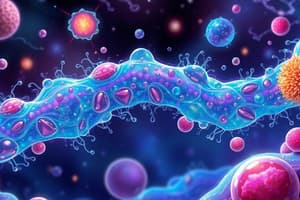Podcast
Questions and Answers
What is the most abundant component in a bacterial cell?
What is the most abundant component in a bacterial cell?
- Carbohydrates
- Water (correct)
- Lipids
- Proteins
What is the result of microbial growth?
What is the result of microbial growth?
- Biofilm formation
- Cell lysis
- Spore production
- Discrete colony (correct)
What is the main carbon source for heterotrophic bacteria?
What is the main carbon source for heterotrophic bacteria?
- Organic molecules (correct)
- CO2
- Inorganic molecules
- Proteins
What are growth factors in microbial nutrition?
What are growth factors in microbial nutrition?
What type of ecological association describes the relationship where one organism benefits and the other is not affected?
What type of ecological association describes the relationship where one organism benefits and the other is not affected?
Which type of organism is free-living and does not rely on others for survival?
Which type of organism is free-living and does not rely on others for survival?
What is the time required for a complete division cycle of bacteria known as?
What is the time required for a complete division cycle of bacteria known as?
What is the phase of growth where cells are adjusting, enlarging, and synthesizing critical proteins and metabolites?
What is the phase of growth where cells are adjusting, enlarging, and synthesizing critical proteins and metabolites?
Which method counts the total dead and live cells in a special microscopic slide containing a premeasured grid?
Which method counts the total dead and live cells in a special microscopic slide containing a premeasured grid?
What is the type of relationship where one organism benefits and the other is harmed?
What is the type of relationship where one organism benefits and the other is harmed?
Which phase of growth is characterized by maximum exponential growth rate of cell division?
Which phase of growth is characterized by maximum exponential growth rate of cell division?
What type of organisms live in close nutritional relationships?
What type of organisms live in close nutritional relationships?
Which type of organisms can survive dry habitats?
Which type of organisms can survive dry habitats?
What is the competition between microorganisms referred to as?
What is the competition between microorganisms referred to as?
Which type of organisms withstand high pressures?
Which type of organisms withstand high pressures?
What type of relationship describes both organisms benefiting?
What type of relationship describes both organisms benefiting?
What is the primary source of energy for photoautotrophs?
What is the primary source of energy for photoautotrophs?
What is the primary source of energy for chemoautotrophs like methanogens?
What is the primary source of energy for chemoautotrophs like methanogens?
What is the primary source of energy for saprobes such as decomposers and parasites?
What is the primary source of energy for saprobes such as decomposers and parasites?
Which process involves the passive movement of molecules from high to low concentration?
Which process involves the passive movement of molecules from high to low concentration?
Which transport process requires energy?
Which transport process requires energy?
What is the primary factor affecting microbial growth and metabolism mentioned in the text?
What is the primary factor affecting microbial growth and metabolism mentioned in the text?
Which type of bacteria thrives in cold temperatures?
Which type of bacteria thrives in cold temperatures?
Which gas most influences microbial growth?
Which gas most influences microbial growth?
What is the diffusion of water through a selectively permeable membrane known as?
What is the diffusion of water through a selectively permeable membrane known as?
Which transport mechanism involves taking in substances without transporting them through the membrane?
Which transport mechanism involves taking in substances without transporting them through the membrane?
What is the primary source of energy for chemoautotrophs?
What is the primary source of energy for chemoautotrophs?
Which transport process involves moving molecules against a gradient?
Which transport process involves moving molecules against a gradient?
Flashcards are hidden until you start studying
Study Notes
Microbial Nutrition, Transport, and Environmental Factors
- Microbes have different nutritional categories based on their carbon and energy sources, including chemoheterotrophs, photoautotrophs, and chemoautotrophs.
- Photoautotrophs derive energy from sunlight and are primary producers of organic matter and oxygen, while chemoautotrophs, like methanogens, use inorganics for energy.
- Nutritional categories of microbes by energy and carbon source are summarized in Table 7.3.
- Saprobes, such as decomposers and parasites, derive both carbon and energy from organic compounds, as shown in Fig. 7.2.
- Transport mechanisms in cells include osmosis, diffusion, active transport, and endocytosis.
- Osmosis is the diffusion of water through a selectively permeable membrane, leading to isotonic, hypotonic, and hypertonic conditions.
- Diffusion is the passive movement of molecules from high to low concentration, while facilitated diffusion involves carrier proteins and is also passive.
- Active transport, requiring energy, moves molecules against a gradient, and endocytosis takes in substances without transporting them through the membrane.
- A summary of transport processes in cells is provided in Table 7.4.
- Environmental factors affecting microbial growth and metabolism include temperature, gas, pH, osmotic pressure, and microbial association.
- Microbes have different ideal temperature ranges for growth, with psychrophiles thriving in cold temperatures and thermophiles in high temperatures.
- Oxygen and carbon dioxide are the gases that most influence microbial growth, with different categories of bacteria based on their oxygen requirements.
Studying That Suits You
Use AI to generate personalized quizzes and flashcards to suit your learning preferences.



